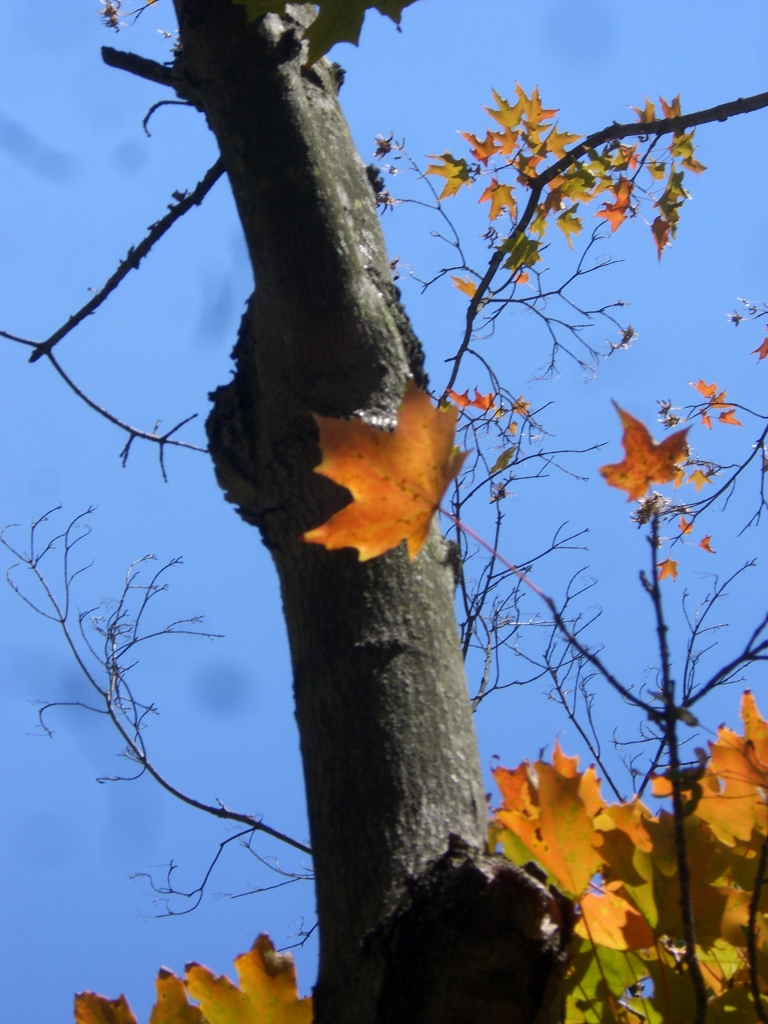Trees
 About a month ago I dropped in to the Glastonbury town hall to register to vote, and while there picked up a little booklet that was a self-guided walking tour of the the trees in the historic district of the town. Gigi and I took advantage of good weather on a recent Sunday to do a part of the walk that goes around the Hubbard Green, including an old cemetery that predates the Revolutionary War.
About a month ago I dropped in to the Glastonbury town hall to register to vote, and while there picked up a little booklet that was a self-guided walking tour of the the trees in the historic district of the town. Gigi and I took advantage of good weather on a recent Sunday to do a part of the walk that goes around the Hubbard Green, including an old cemetery that predates the Revolutionary War.
As our guide book indicated, there are indeed many trees around the area of various stripes, including the Sugar Maple (pictured at left), Eastern Redbud, Norway Spruce and Maple, White Fir, Pin Oak, and the Thornless Honeylocust, which is a very pretty tree that turns bright yellow in early autumn.
 We also took a side trip to the old Green Cemetery along the way, and inspected the grave markers and memorials. This one in particular (at right) was interesting. Erected in 1777, it memorializes one fellow, a Thomas Kimberly who was at the powder mill here when it “took fire and blew up”.
We also took a side trip to the old Green Cemetery along the way, and inspected the grave markers and memorials. This one in particular (at right) was interesting. Erected in 1777, it memorializes one fellow, a Thomas Kimberly who was at the powder mill here when it “took fire and blew up”.
Armed with this new body of knowledge, our hope is to go back to our house and try to identify the various trees and shrubs around the yard. Other than the maples, the only other tree I had positively identified was the Ginkgo Biloba tree.
The Squirrels Join In the Cause
Just yesterday I was working at my desk when I spotted one of the squirrels out back, carrying in its mouth a large round object, larger than its head. I was sure it had just stolen one of our tomatoes, and so got up to follow its progress across the yard. It seemed to be in a great hurry, and must have known somehow that it had struck pay-dirt and was now making its getaway. When I went into the sunroom, Gigi (who has claimed the room as her office) noted that she saw the squirrel taking off like a bat out of hell (or at least a squirrel out of hell) and that it went around to the side of the house. We finally spotted it off by the well-pump and saw that in fact it did not have a tomato, but a large spiny ball about two inches in diameter. There was a hole in one side, and half the squirrel’s head was buried in that hole, furiously gnawing away on something.
 Our best guess is that this spiny “tribble” like object is a chestnut. The last time we saw things that looked like this was during our hiking trip through Spain, where these things were ubiquitous in the forests of the foothills of Garrotxa; our friends Steve and Esther were quick to identify them as European chestnuts. After walking around the backyard for a while this morning I was able to capture one of these tribbles intact and get a picture of it. From my tree-spotting guides online, the best guess I have so far is that this is from a Chinese Chestnut tree. There are still some American Chestnuts around, but they are mostly seedlings, that only live long enough to produce fruit before they die from its eponymous blight.
Our best guess is that this spiny “tribble” like object is a chestnut. The last time we saw things that looked like this was during our hiking trip through Spain, where these things were ubiquitous in the forests of the foothills of Garrotxa; our friends Steve and Esther were quick to identify them as European chestnuts. After walking around the backyard for a while this morning I was able to capture one of these tribbles intact and get a picture of it. From my tree-spotting guides online, the best guess I have so far is that this is from a Chinese Chestnut tree. There are still some American Chestnuts around, but they are mostly seedlings, that only live long enough to produce fruit before they die from its eponymous blight.
